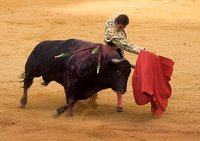Why do bulls attack the color red?
 Strangely enough bulls are colorblind. To a bull's eye, a red cape is a gray cape. The red cape, which inspired the phrase "seeing red," is purely a theatrical tradition.
Strangely enough bulls are colorblind. To a bull's eye, a red cape is a gray cape. The red cape, which inspired the phrase "seeing red," is purely a theatrical tradition.However, to a bull bred exclusively for aggressiveness, that flapping cape can prove very irritating. A nimals bred for bullfighting are tested around the age of three for aggressiveness before they go into the ring. The orneriest ones make the cut.
It's also worth pointing out that the animal in question has already been stabbed several times at the base of the neck. This happens early in the bullfight, and is performed by a gentleman known as a "picador."
And as we discovered on the Bullfighting FAQ website, two kinds of capes are used in bullfighting. The capote is a large, flowing cape which is magenta and yellow. The muleta, a smaller red cape, is used exclusively by the matador for the faena, or the final, fatal segment of the bullfight.
Receive post updates by Email



























 Add my feed to your Rss
Add my feed to your Rss
